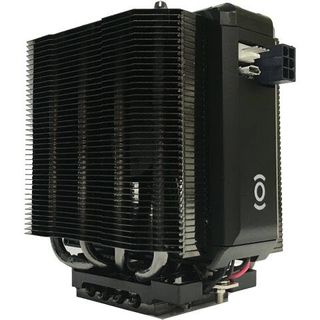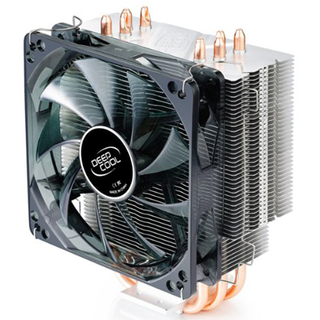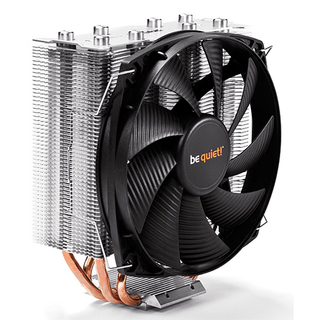Phononic HEX 2.0 Thermoelectric Mid-Sized CPU Cooler Review
Why you can trust Tom's Hardware
Test Results And Conclusion
The HEX 2.0’s low 4.9” height is unmatched by any of our recently-tested cross-flow coolers, yet Phononic uses TEC technology to target customers of those larger cooling solutions.
"With the HEX 2.0, we have created a new category of CPU cooling by offering an alternative for high performance cooling without going to a much larger heat sink/fan or a water-based solution," said Michael Bruno, vice president and general manager of Phononic's Electronics Cooling business unit.
Here's how its mid-sized dimensions compare to the smallest of recently-reviewed Big Air CPU coolers.
We retain the hardware configuration from previous reviews to make all of our results comparable. With the stage set, let’s see how it performs against these models!

If you’re wondering why we’re not showing results for all three HEX 2.0 operational modes, it’s because our CPU’s heat output pushes the HEX 2.0 past its highest TEC engagement temperature. We tested it all three ways and got the same numbers three times, edging out the Noctua NH-U12S at full fans.

A great amount of air is needed to move the extra 40W of power consumed by the TEC, in addition to CPU cooling, yet the HEX 2.0’s fan is a little smaller than those of its Big Air competitors. Phononic relies on increased fan motor RPM to create the extra airflow.
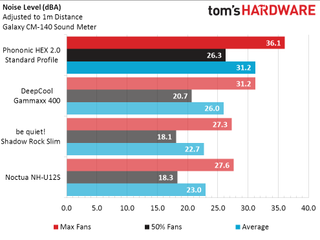
Faster fans mean more noise. We’re still seeing lower noise levels than many of the graphics cards we test, but the HEX 2.0’s fans are noticeably louder than the big slow-spinning parts of “Big Air” designs.
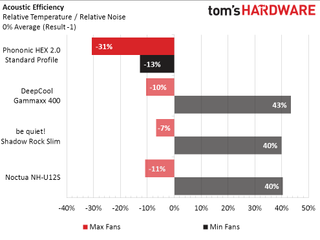
Even though it’s only slightly noisy, higher noise teams together with middling cooling performance to hurt the HEX 2.0’s cooling to noise ratio.
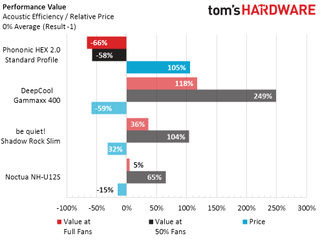
You’ll also pay for the TEC. The HEX 2.0 costs roughly three times as much as a Big Air cooler while offering similar cooling and greater noise. The true market then is for buyers who can’t fit a Big Air unit.
All the charts point in the single direction: the HEX 2.0 performs fairly well for its size, but at a fairly steep price. While we’re sure that a few websites with short memories and lots of marketing enthusiasm will promote taglines such as “Revolutionary” and “Disruptive,” the truth is that the HEX 2.0 is a fairly solid cooler built on time-proven technology. The biggest improvement is that, unlike previously-reviewed units with high-wattage TEC elements, the HEX 2.0 doesn’t hum while switching on and off. And that might just be something to hum home about.
MORE: Best CPU Cooling
MORE: All Cooling Content
MORE: How To Choose A CPU Cooler
Follow us on
Facebook, Google+, RSS, Twitter and YouTube.
Stay on the Cutting Edge
Join the experts who read Tom's Hardware for the inside track on enthusiast PC tech news — and have for over 25 years. We'll send breaking news and in-depth reviews of CPUs, GPUs, AI, maker hardware and more straight to your inbox.
-
Stevemeister A very diplomatically worded conclusion. As a mechanical engineer let me summarize:Reply
1. It's an overly complicated engineering solution looking for a problem
2. It doesn't work as well as air coolers costing half the price
3. Closed loop liquid coolers will perform way better for the same or less $
4. It adds ~40W to your system's overall power consumption
If this was being promoted on Dragon's Den as an investment opportunity I'd take a pass. -
JakeWearingKhakis I think it is pretty damn cool. I'd love to have one, it would make a nice conversation piece.Reply
Stevemeister is right though. An over complicated solution that needs to find a problem. If the price was less than $100, then it would do much better for people who like technology and want to have neat things? -
mapesdhs If one can't fit a large air cooler, then just use an AIO, works very well. The only caveat is that many AIOs use rather loud fans, so I replace them with better models.Reply -
basroil This cooler looks like a PoS as far as CPU cooling goes, but if you can mod the firmware, you might be able to make a nifty (but expensive) beer cooler. I helped make a TEC cooler using a thermalright 140mm tower and two (different sized) TEC plates to get dT of ~30C. Sure it needed ~20W, but it gave you an ice cold beer in an hour or so.Reply -
serendipiti Not sure of the intended use of this device. What should add above liquid cooling o big size air coolers ? Shouldn't be a better temperature management: should perform like a temperature wall: no matter how much heat your CPU dissipates because the Peltier should keep temps below that point. I wonder if the tests done only show a linear behaviour before hitting the "wall" and going to insane overclock would show a different behaviour which would justify the expense...Reply -
JakeWearingKhakis serendipiti good point.Reply
If this tech can keep the temps from hitting a certain point no matter what then yes. -
Memhorder I was expecting better for the price and power consumption geez. It just doesn't make sense cooling the CPU with the cold side of the TEC Then using a large fin array to cool the Hot side anyways for worse performance. All for 2 centimetersReply -
bit_user Reply
Maybe I don't know what you mean by AIO, but there are a few downdraft coolers that can comfortably handle 130 W. I use a Scythe Big Shuriken 2 Rev B, but replaced the fan with a Noctua 150 mm .18282039 said:If one can't fit a large air cooler, then just use an AIO, works very well. The only caveat is that many AIOs use rather loud fans, so I replace them with better models.
This has the added advantage of providing RAM and VRM cooling, as well.
-
gdmaclew I too was expecting a better performance from this unique device. I was first introduced to them around 1980 when the first portable drink coolers came out.Reply
I guess the reason why it didn't perform better was for the reason stated in the article...the hot exhaust air is being exhausted inside the enclosure, instead of outside it. If somehow the unit could draw in cool air from outside the case and then exhaust it outside the case, it would work much better, just like a beer cooler.
Still it is an interesting application to a common PC problem.
